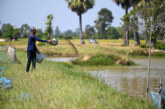Dr. Arvind Kumar*
Experts on disaster management suggest the adoption of integrated watershed management by advocating coordinated development planning at a watershed scale with collective endeavours by local administrations and other stakeholders. They also emphasize control through strict implementation of land-use regulations over illegal human encroachment on river corridors along with basing rock and sand mining policies on sound scientific analysis.

The United Nations Climate Change Conference COP27 closed in November with a breakthrough agreement to provide “loss and damage” funding for vulnerable countries hit hard by climate disasters. This determines a way forward on a decades-long conversation on funding for loss and damage – deliberating over how to address the impacts on communities whose lives and livelihoods have been ruined by the very worst impacts of climate change. Increasingly, we are seeing that countries are being hit with one disaster after another, such as drought followed by fires followed by floods. The compounding effect of these disasters is taking a heavy toll on environment and socioeconomic factors. Immediate impacts of floods include property damage, destruction of crops and livestock, clean up costs and emergency response. According to the stark report by UNFCCC, implementation of current pledges by national governments put the world on track for a 2.5°C warmer world by the end of the century. The IPCC indicates that greenhouse gas emissions must decline 45% by 2030 to limit global warming to 1.5°C.The reality is that this is the world we live in with 1.1degrees C of warming. These records temperatures, record floods are not anomalous, they are the beginning of new norms, and the new records will continue to be exceeded, year after year. In Southeast Asia we have witnessed extreme floods in Pakistan, in Bangladesh, in Nepal and also in India especially in cities of Bangalore, Chennai and in states of Assam and Meghalaya.
Closer home visitation of floods is a perennial annual phenomenon especially in Northeast India causing huge loss of human lives and animal stock, crops, infrastructure, and livelihoods. The unique topographical and geographical location of the Northeast region of India along with its hydro-meteorological situation has proved instrumental in making this region one of the highest rainfall zones globally having an annual rainfall of 2000 mm. Endowed with a thick network of drainage channels and as many as 7 river basins, this region is blessed with abundant water resources, which have not been adequately tapped or utilized or conserved, and the resultant impacts are discernible in the form of frequent visitation of floods and other water-related hazards from time to time.
Climate scientists have been predicting for so many years that greenhouse gases contributing to global warming render the atmosphere become hotter, and the hot air holds more water vapours, so when it rains, it rains harder thereby causing floods and other water-related hazards. Climate scientists argue that a lot of rainfall within a short span of time and the inability of the already saturated ground to soak the rainwater renders the water to be pooled on the surface where topsy-turvy terrain pushes the water downhill there by culminating in a flash flood and that can be extremely dangerous.
Economic Fallout of Floods

According to broad estimates, floods and other water-related hazards like storms and hurricanes could cause $ 5.6 trillion in losses to the global economy by 2050. Heavy rains during 2022 have reportedly spurred floods that inundated cities in China, South Korea, Pakistan, India, and many other countries causing irreparable loss of human lives and property. Water-related hazards are costing immense economic losses in developing countries. According to the Emergency Events Database maintained by the Brussels-based Centre for Research on the Epidemiology Disasters, extreme weather events like droughts, storms, and floods led to global losses of more than $ 224 billion in 2021.
In view of the projections by various reports by the Intergovernmental Panel on Climate Change (IPCC), about climate change fueling more intense rainfall, flooding and drought in ensuing decades, the economic costs are set to soar. According to Don Holland, a Canadian water market expert, water – when there is too much or too little – can be the most destructive force. According to broad estimates about losses countries could incur in terms of immediate costs as well as to the overall economy on account of water-related hazards, the losses for the US could total $ 3.7 trillion by 2050 and China could face cumulative losses to the tune of $ 1.1 trillion by the mid-century. The sectors to be adversely impacted by floods and storms, inter alia, include infrastructure and inventory, agriculture, retail, banking and energy.
Visitation of floods along with droughts is a recurring annual phenomenon in India, and these floods not only come early but they stay longer as well. And most often these floods are not proportionate to the rainfall. The data available with the DTE-CSE Data Centre of the Central Water Commission (CWC) show that from 1952 to 2018, there has not been a single year when a flood did not affect the country with considerable losses to lives and property. It further reveals that during this period, 109, 412 people lost their lives, over 258 million of hectares of crops were damaged and 81, 187, 187 houses were raged, and the cumulative economic losses amounted to ₹ 4.69 trillion. According to media reports, India suffered a loss of ₹ 95, 736 crore in the 2018 floods, which was 2.6 times more than the financial loss due to floods in 2017.
Assam is said to be the most vulnerable state in the Northeast in particular and India in general which is susceptible to the vagaries of climate change, especially flooding. In 2022, Assam faced the worst kind of flood in its history with at least 90 percent of the state’s districts flooded and more than 50, 000 people being housed in relief camps. According to media reports, about 40 percent of the state is impacted every year in three-four waves of the deluge. According to Asian Development Bank (ADB) estimates, floods constitute the most devastating among climate-related disasters in India and account for more than 50% of all climate-related disasters. In Meghalaya rain has been unprecedented; in some areas it has broken records of the past 40 years causing floods in various parts of the state. Assam is said to have incurred damages worth nearly ₹10, 000 crore in recent floods.
Managing Floods
Conceding that there is no catch-all solution to the flooding in the Northeast region in general and Assam in particular owing to thepresence of unique problems at each location, many experts argue that flood hazard management calls for strong and long-term political, technical, and financial commitments, supported by comprehensive assessments based on regular monitoring. Experts emphasize the need for granular data to support hazard assessment, development planning, and monitoring in a large number of watersheds. Emphasis is also stressed on hydro-meteorological observations along with making available remote-sensing technologies. There is a need for prioritizing the enhancement of the capacities of local governments and other stakeholders.

Nevertheless, ADB experts on disaster management suggest the adoption of integrated watershed management by advocating coordinated development planning at a watershed scale with collective endeavours by local administrations and other stakeholders. They also emphasize control through strict implementation of land-use regulations over illegal human encroachment on river corridors along with basing rock and sand mining policies on sound scientific analysis. These experts call for the essentiality of nature-based solutions which comprise reforestation, wetland restoration, and land-use regulation that may be helpful in intercepting rainfall delay, rainfall-runoff, and minimising soil erosion, and thus flood severity.
These experts also call for according priority to the installation of sediment barriers, inserting boulders, enhancement of riverbanks, riverbed protections and other such related measures to “train” the river to find its equilibrium and not change its course, and these measures can be helpful in reducing flood management investment in downstream areas with large infrastructure like flood dikes. There is also a need for exploring the links between extreme weather events and climate anomalies to improve long-term flood forecasting and early warning at the level of each state of the Northeast.
Things to ponder on
The Northeast region is a very significant biodiversity hotspot which calls for prioritizing disaster risk reduction strategies that are backed by scientific and technological support systems to protect the region from the lethal permanent damage from water-related hazards and disasters due to illegal construction, unregulated mining and structural problems which are also responsible for aggravating the situation Undoubtedly, under the given capabilities, disasters cannot be stopped from taking place; nonetheless, equipping stakeholders with sufficient knowledge and technology to envisage disaster preparedness, loss of lives and property can be saved. With abundant natural resources, mesmerising landscapes and rich socio-cultural heritage along with its increasing geopolitical and geo-economic significance in India’s Act East Policy, the Northeast region requires robust disaster management strategies.
*President, India Water Foundation



